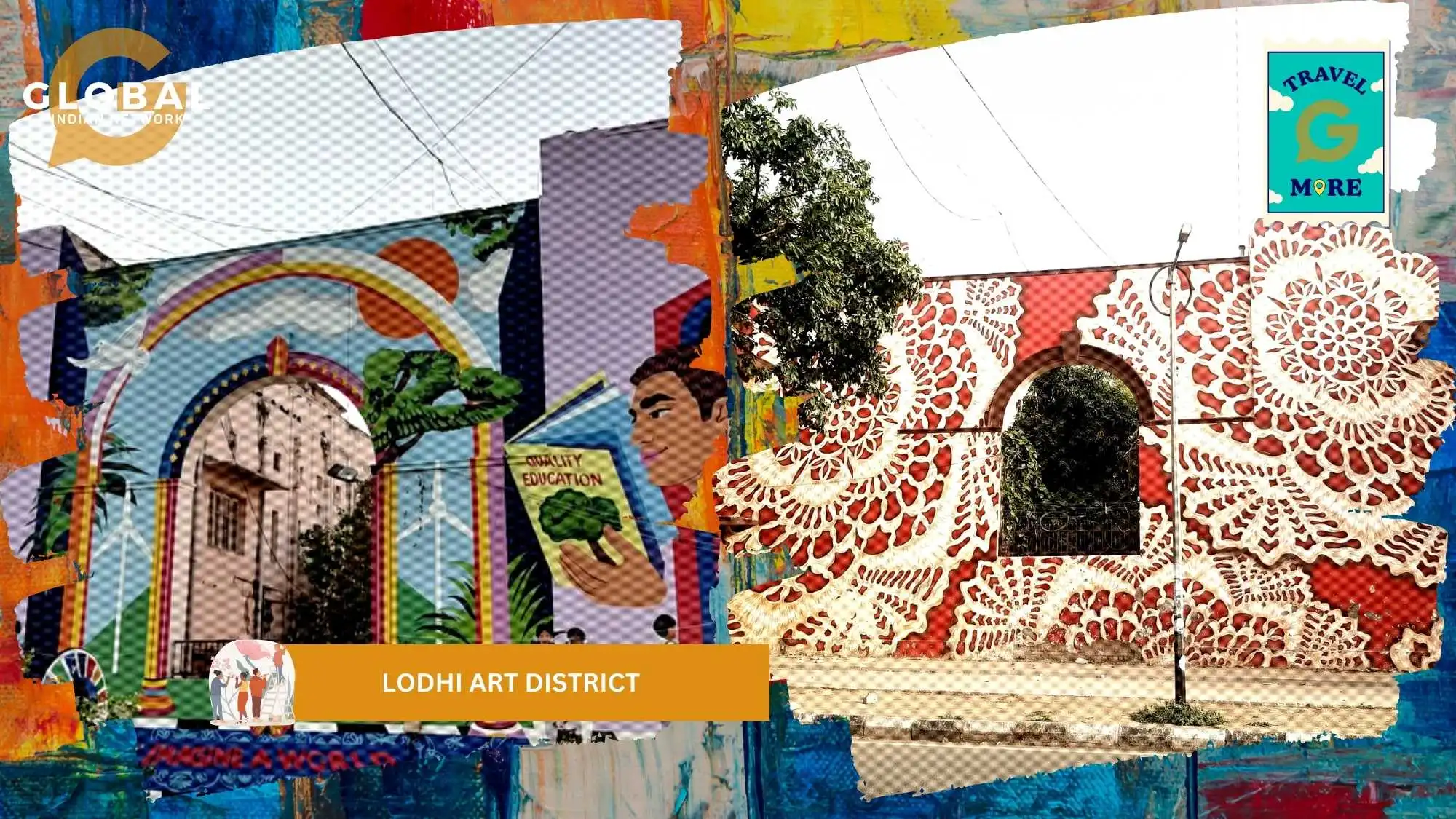In the heart of India’s capital city lies a neighbourhood that has redefined how urban India perceives art in public spaces, the Lodhi Art District. Once an understated residential quarter, the last housing estate built by the Britishers, Lodhi Colony, has been radically transformed into a radiant open-air gallery, alive with murals and visual narratives that hold a part of the history of India. This metamorphosis did not happen overnight. Rather, it evolved through a unique synergy of vision, community, and artistic stewardship that has rewritten both the map and the imagination of New Delhi.
Table of Contents
Lodhi Art District: A Colonial-Era Beginning
Built in the 1940s under the last phase of British colonial urban planning, Lodhi Colony was conceived as part of the expansion around Lutyens’ Delhi. Its architecture was functional and regimented, low-rise, pastel-coloured blocks marked by arched doorways, repetitive balconies, and clean geometric proportions. Unlike Connaught Place or the Rashtrapati Bhavan complex, Lodhi Colony was unembellished. It instead served as residential housing for government officers, particularly those affiliated with the Defence and Public Works departments.
And yet, it was exactly this uniformity, including symmetrical walls, facades, and pavements, that would, many decades later, become the perfect scaffold for a revolution in urban art.
The Spark of Reimagination (2014–2016)
The turning point came in 2014, when St+art India Foundation, which is a not-for-profit organisation seeking to make art democratic and accessible, partnered with the Central Public Works Department (CPWD) to explore the possibility of turning public walls into storytelling platforms. Inspired by global street art hubs such as Berlin, London’s Shoreditch, and Wynwood Walls in Miami, they envisioned Lodhi Colony as India’s first organized public art district.
By 2015, the first edition of the Lodhi Art Festival was launched. Artists were invited from across India and abroad to paint murals on selected walls between Khanna Market and Meherchand Market. Rather than isolating art behind gallery doors, this project invited Delhi’s residents to walk amidst it, stumble upon it organically, and interpret it casually in everyday life. Thus began the birth of the Lodhi Art District.

Transformative Murals
Over the next several years, the district bloomed- one wall at a time. Between 2016 and 2019, the neighbourhood hosted more than 50 artists spanning over 15 countries, each bringing a unique style and narrative.
The District showcases a diverse range of murals, carrying distinct themes and stories. NeSpoon from Poland created a lace-inspired artwork celebrating womanhood and cultural craftsmanship, displayed symbolically on International Women’s Day in 2019. The Aravani Art Project contributed a collaborative mural on Block 5 that foregrounded transgender inclusion and gave visibility to marginalised voices. Indian artists Avinash and Kamesh painted The Tourist, a witty critique of the selfie generation that turned viewers into both spectators and spectacles.
From Singapore, Yip Yew Chong brought slice-of-life scenes drawn from Lodhi Colony’s everyday rhythms, offering residents intimate visual anchors. Sameer Kulavoor’s “Social Media Friendly Plants” added humour and satire by pointing out society’s obsession with appearances over authenticity. Together, these works, spanning themes of mythology, folklore, climate change, mental health, identity politics, technology, and urban alienation, transformed the neighbourhood walls into vibrant conversation pieces.
Community and Cultural Impact
What made the Lodhi Art District remarkable was not just the scale of its murals, but the culture it created. Residents were not displaced or marginalised by the project; rather, they participated in its making. Children watched artists work, occasionally offering help. Shopkeepers adjusted signboards to reveal portions of murals. Elderly residents narrated their own histories as artists sought local inspiration.
The Lodhi Art District transformed a once humdrum neighbourhood into an uproarious hub that attracted both travellers and locals. Its impact extended beyond tourism, as cafés, handicraft stores, and bookstores began to thrive around the art trail, boosting the local economy. Residents developed a strong sense of ownership and pride in their area’s new cultural identity, while schools, art students, and the general public were drawn to experience art up close. Unlike traditional gallery systems that often feel elitist, the Lodhi Art District removed all barriers- no tickets, guards, or dress codes, thus making cultural experiences accessible and democratic for everyone.
Continued Evolution: 2020s and Beyond
By 2020, the Lodhi Art District hosted nearly 60 large-scale murals. The place has also seen several notable developments that have added depth and dimension to the experience. St+art India regularly organises workshops and walking tours, allowing visitors to engage with the artworks through layered narratives, local folklore, and behind-the-scenes stories of the artists and their creative processes. To keep the space dynamic and interactive, modern features such as light installations and QR codes have been introduced, offering viewers a chance to explore more about the art and the ideas behind it.
The success of this initiative has inspired the growth of similar street-art clusters in other parts of Delhi, such as Shahpur Jat and Hauz Khas Village, further extending the reach of public art and weaving creativity into the core of the city.
Conclusion
This place, I’ve never been to, but still feels like home for some reason. Art may be the cause. Too much, maybe the cause. The Lodhi Art District (or heaven for me) began in 2015 with just two trial murals painted on CPWD housing blocks in South Delhi. The idea quickly expanded, and by 2019, the colony featured over 50 murals created by artists from India and abroad, supported by St+art India Foundation in collaboration with Asian Paints, NDMC, and various embassies.
Today, it stands as India’s first and only open-air art district, visited by tourists, students, and locals alike. The project has also sparked similar initiatives in other parts of Delhi, such as Shahpur Jat and Hauz Khas, showing how public art can transform ordinary neighbourhoods into cultural landmarks. It reminds us that cities are not just made up of buildings and roads, but of unnamed metaphors, and that sometimes, painting a wall can change the way we inhabit not just a neighbourhood but our very idea of art and community.

FAQs
What to do in the Lodhi Art District?
Visitors can explore mesmerising street art spread across the walls of Lodhi Colony. The district offers walking tours, photography opportunities, and a chance to see works by both Indian and international artists. It’s also a popular place for art events and cultural walks.
Which metro station is near the Lodhi Art District?
The nearest metro station is JLN (Jawaharlal Nehru) Stadium Metro Station on the Violet Line or Jor Bagh on the Yellow Line. From there, it’s a walk of about 15-20 minutes.
When was the Lodhi Art District established?
Lodhi Art District began in 2015 as a project by St+art India Foundation, making it India’s first and largest open-air public art gallery.
How many murals are in the Lodhi Art District?
There are around 65 murals created by more than 30 artists from India and abroad. The artworks cover themes like social issues, culture, environment, and community.









